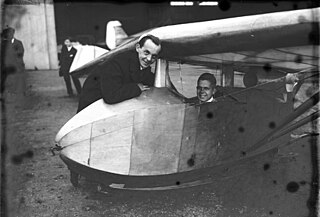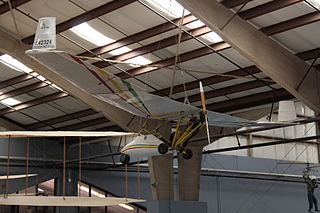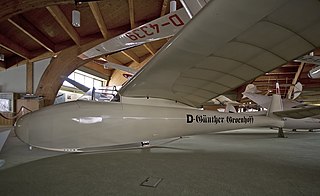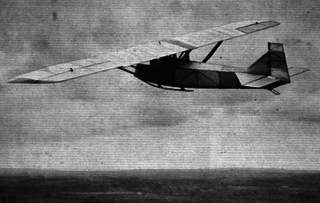
Alexander Martin Lippisch was a German aeronautical engineer, a pioneer of aerodynamics who made important contributions to the understanding of tailless aircraft, delta wings and the ground effect, and also worked in the U.S. Within the Opel-RAK program, he was the designer of the world's first rocket-powered glider.

The Akaflieg Darmstadt D-7 Margarete, often shortened to Darmstadt D-7 Margarete, was one of the earliest two seat monoplane gliders, designed and built by German university students in 1923.

The DFS Rhönsperber, otherwise known as the Schweyer Rhönsperber or Jacobs Rhönsperber was a single seat competition glider designed in Germany by Hans Jacobs and first flown in 1935. For several years it was regarded as the best German sailplane and about one hundred were built.

The DFS Reiher was a single seat competition glider designed in Germany by Hans Jacobs and first flown in 1937. The type won the last two German Rhön gliding championships before the start of World War II. Six were factory produced.

The Mitchell Wing B-10 is an American high-wing, open cockpit, single-seat, tailless, ultralight aircraft and motor glider designed by Don Mitchell and based on his Mitchell Wing hang-glider. It has been produced by a variety of companies in the form of kits and plans for amateur construction. It first flew in 1980.

The Schleicher Rhönadler, DFS Rhönadler or Jacobs Rhönadler is a high performance, single seat competition sailplane built in Germany in the 1930s. More than 65 were built.

The Lippisch Wien was a high-performance glider designed by Alexander Lippisch in Germany in 1929. Owned and flown by Robert Kronfeld, it was one of the first sailplanes intended to exploit thermals. It set world records both for distance and altitude and demonstrated the practicality of long-distance cross-country flights.
The Bonomi BS.22 Alzavola was a training motor glider, intended to acquaint capable glider pilots with the characteristics of powered aircraft. The sole example was designed and built in Italy in the mid-1930s.
The Teichfuss Cicogna was an Italian tailless single-seat motor glider designed by Luigi Teichfuss and flown in 1936.

The RRG Fafnir, named after the legendary dragon, was a single seat German high performance glider designed by Alexander Lippisch. It won the Rhön competition in 1931 and made several outstanding flights as well as setting a fashion for gull wings.

The RRG Fafnir 2 São Paulo, named after the legendary dragon and the Brazilian city which partially financed it, was a single seat German high performance glider designed by Alexander Lippisch. It set a new world distance record in 1934 and won the 1937 International Gliding Championships.
The RRG Professor was a very early soaring glider and the first to use a variometer for finding thermals. It was designed by Alexander Lippisch in Germany, first flying in 1928. The Professor was widely built by both flying clubs and factories.
The RRG Urubu Obs, often known just as the RRG Obs, was a one-off, large, two or three seat glider designed for meteorological observations by Alexander Lippisch in Germany and first flown in 1932.

The RRG Falke of 1930 was a secondary training glider designed by Alexander Lippisch in Germany and intended to provide better performance than his earlier RRG Prüfling whilst being easier to fly because of its inherent stability. It was sold as plans for both club and commercial production and was built in Germany and abroad.

The 1926 German RRG Prüfling of 1926 was a secondary training glider designed for club use. Plans were sold and it was built in Germany and across the world.

Lore and a copy, Musterle, were high performance sailplanes designed at Darmstadt by Paul Laubenthal. Lore was flown successfully by the well known glider pilot Wolf Hirth at the 1929 Rhön (Wasserkuppe) glider competition. Musterle was used by Hirth used to demonstrate the possibilities of "blue sky" thermalling for the first time.

The RRG Storch V was the only member of Alexander Lippisch's Storch series of tailless aircraft to be powered. It flew successfully in the year 1929.
The Avia 50-MP was a French motor glider based on that of the Avia XV-A training glider. First flown in 1934, it was intended to introduce pilots to motor-gliders.

The Naleszkiewicz JN 1 was an experimental tailless sailplane designed in Poland to explore the aerodynamic properties of a proposed powered tailless aircraft. It proved hard to fly and a crash led to its abandonment after only a few months of limited testing.

The Kharkiv KhAI-4 was an experimental Soviet tailless aircraft tested in 1934. It only made three flights before being grounded as dangerous.


















